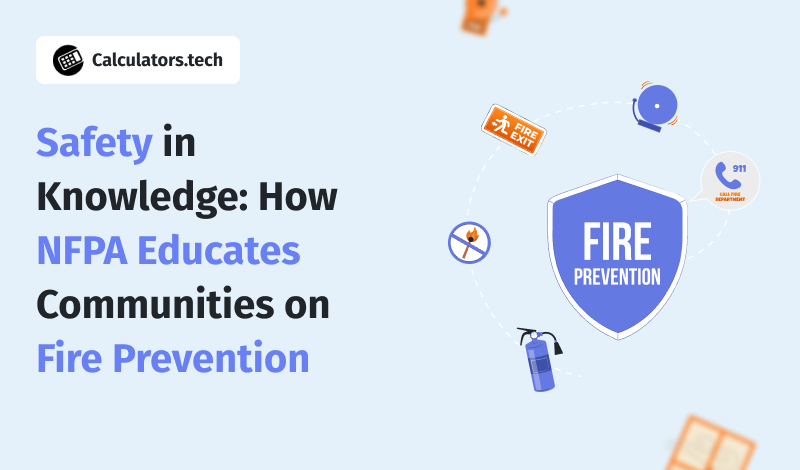Safety in Knowledge: How NFPA Educates Communities on Fire Prevention
Fire prevention is essential to community safety; no organization exemplifies this more than the National Fire Protection Association (NFPA). Through various educational programs, resources, and initiatives, the NFPA has empowered communities with the knowledge they need to prevent fires and protect lives. A key component of this effort is NFPA adherence, which ensures that safety standards are met consistently. Let's explore how the NFPA educates communities on fire prevention, emphasizing the importance of safety in knowledge.
The Power of Information
The NFPA's mission is to eliminate death, injury, property, and economic loss due to fire, electrical, and related hazards. They believe that an informed community is a safer community. By providing accessible, accurate, and actionable information, the NFPA equips individuals and communities with the tools to mitigate fire risks and reduce the likelihood of an unexpected death.
Fire Prevention Week
One of the NFPA's most significant initiatives is Fire Prevention Week, held annually in October. Established in 1922, it is the record's longest-running public health and safety observance. Each year, the NFPA selects a theme to highlight a specific aspect of fire prevention. Themes range from smoke alarm maintenance to escape planning, designed to address current fire safety challenges.
During Fire Prevention Week, the NFPA provides a wealth of resources, including educational materials, activity guides, and promotional content, to raise awareness and ensure NFPA adherence. Schools, businesses, and community organizations often organize events and activities promoting fire safety, emphasizing the importance of following these guidelines.
Educational Resources for All Ages
The NFPA understands that fire prevention education must start early and continue throughout life. Therefore, they offer a variety of resources tailored to different age groups:
Children
Sparky the Fire Dog, the NFPA's beloved mascot, is a central figure in their efforts to educate young children. Through interactive games, videos, and storybooks, Sparky teaches kids essential fire safety tips in a fun and engaging way. The Sparky School House website is a valuable resource for teachers and parents, offering lesson plans, activities, and educational videos that align with curriculum standards.
Teens
The NFPA provides resources for older students that address more complex fire safety topics. High school teachers can access lesson plans and presentations that cover fire science, emergency planning, and the importance of fire-safe behaviors. These materials educate and encourage students to think critically about fire safety daily.
Adults
The NFPA offers numerous resources for adults, including comprehensive guides on home fire safety, workplace fire prevention, and emergency preparedness. Their Home Fire Safety Checklist and Fire Safety for Older Adults guide are particularly popular, providing practical tips that anyone can implement.
Leveraging Technology
In today's digital age, the NFPA leverages technology to reach a broader audience. Their website, NFPA.org, is a treasure trove of information featuring articles, reports, and interactive tools. The NFPA's online learning portals offer courses and webinars on various fire safety topics, enabling individuals to learn at their own pace.
Social media is another powerful tool in the NFPA's educational arsenal. By sharing tips, infographics, and videos on platforms like Facebook, Twitter, and Instagram, the NFPA reaches millions of people worldwide. Their YouTube channel features various informative videos, from fire prevention tips to virtual tours of fire-safe homes.
Community Outreach Programs
The NFPA's commitment to community education extends beyond digital resources. They actively engage with communities through outreach programs and partnerships. One such program is the Steps to Safety™ program, which teaches older adults to be safe from fires and falls. By working with local organizations and volunteers, the NFPA ensures that these vital safety messages reach those who need them most.
Another notable initiative is the NFPA’s Wildfire Community Preparedness Day. This program encourages communities in wildfire-prone areas to proactively reduce their wildfire risk. By organizing local events and activities, participants learn about fire-resistant landscaping, emergency planning, and the importance of community cooperation in wildfire prevention.
The Role of Standards and Codes
In addition to educational efforts, the NFPA plays a crucial role in developing fire safety standards and codes. These standards, such as the National Electrical Code (NEC) and the Life Safety Code (NFPA 101), set the benchmark for fire safety practices in various settings, including construction sites in Australia and the NFPA fire extinguisher requirements. While primarily aimed at professionals, these standards also significantly impact public safety, particularly for workers and visitors at Australian construction sites where fire risks may be elevated.
The NFPA ensures that developing these codes is transparent and inclusive, involving input from various stakeholders. Public education campaigns often accompany the release of new or updated standards, helping communities understand their importance and how to comply with them.
Conclusion
The NFPA's commitment to fire prevention education highlights the importance of knowledge in protecting communities. By offering accessible resources, utilizing technology, and engaging in outreach, the NFPA empowers individuals to prevent fires proactively. Through initiatives like Fire Prevention Week and comprehensive standards, they emphasize the need for awareness and vigilance. Safety in knowledge is more than a slogan—it's a lifesaving principle. To explore fire prevention resources, visit NFPA.org today.
